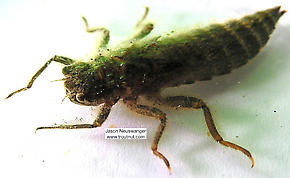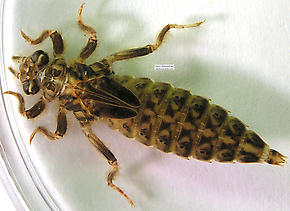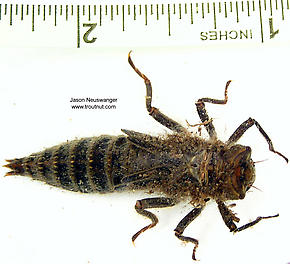Blog & Latest Updates
Fly Fishing Articles
Insects by Common Name


Insect Order Odonata-Anisoptera (Dragonflies)
Taxonomic Navigation -?-
Kingdom
Animalia (Animals)
» Phylum
Arthropoda (Arthropods)
» Class
Insecta (Insects)
» Order Odonata-Anisoptera (Dragonflies)
| Family in Odonata-Anisoptera | ||
| Aeshnidae | 0 | 0 |
| Cordulegastridae | 0 | 0 |
| Gomphidae | 0 | 0 |
| Libellulidae | 0 | 0 |
2 families aren't included.
Common Name
| Match | Common Name |
| Dragonflies |
Hatching Behavior
Dragonfly nymphs emerge by crawling up various objects out of the water, so the emergence is not important. Freshly emerged flies may have a little trouble flying and end up on the water, but emergence is so sporadic that this activity never causes a good rise of fish, let alone selective feeding. The lone, struggling stray may draw an explosive rise.
Egg-Laying Behavior
Adult dragonflies are so good at flying that they very rarely end up on the water and never in good numbers. They live for a long time as adults and feed heavily on other insects in mid-air. It's great fun to watch one twist its way through a cloud of tiny midges with aerial maneuvers beyond Lockheed Martin's wildest dreams. Dragonflies are also good indicators of impending mayfly spinner falls: just like swallows and waxwings, they swoop among the spinner swarms at treetop level long before the smaller mayflies are low enough to be spotted.
Juvenile Biology
Diet: Other insects, small fish
Dragonfly nymphs are extremely good predators, and they're by far the most important stage of this order for trout. They are especially common in slow or still water, where they crawl around or swim by intaking water through their mouths and propelling it out their posteriors like a tiny jet. A dead-drift (Dead-drift: The manner in which a fly drifts on the water when not moving by itself or by the influence of a line. Trout often prefer dead-drifting prey and imitating the dead-drift in tricky currents is a major challenge of fly fishing.) presentation or a jerked retreive is ideal.Pictures of 12 Dragonfly Specimens:
Cordulegaster Dragonfly Nymph View 4 PicturesThis is a realy big, dark dragonfly nymph. Notice how "fuzzy" it is--it's covered with small hairs that collect sediment and debris and camouflage the nymph to match its natural surroundings. The greenish cast in some of the photos of this specimen is due to strange lighting during my first night photographing things for this site.
View 4 PicturesThis is a realy big, dark dragonfly nymph. Notice how "fuzzy" it is--it's covered with small hairs that collect sediment and debris and camouflage the nymph to match its natural surroundings. The greenish cast in some of the photos of this specimen is due to strange lighting during my first night photographing things for this site.
 View 4 PicturesThis is a realy big, dark dragonfly nymph. Notice how "fuzzy" it is--it's covered with small hairs that collect sediment and debris and camouflage the nymph to match its natural surroundings. The greenish cast in some of the photos of this specimen is due to strange lighting during my first night photographing things for this site.
View 4 PicturesThis is a realy big, dark dragonfly nymph. Notice how "fuzzy" it is--it's covered with small hairs that collect sediment and debris and camouflage the nymph to match its natural surroundings. The greenish cast in some of the photos of this specimen is due to strange lighting during my first night photographing things for this site.Collected January 13, 2004 from the Namekagon River in Wisconsin
Added to Troutnut.com by Troutnut on January 25, 2006
Added to Troutnut.com by Troutnut on January 25, 2006
Gomphidae Dragonfly Nymph View 3 Pictures
View 3 Pictures
 View 3 Pictures
View 3 PicturesCollected January 13, 2004 from the Namekagon River in Wisconsin
Added to Troutnut.com by Troutnut on January 25, 2006
Added to Troutnut.com by Troutnut on January 25, 2006
Cordulegaster Dragonfly Nymph View 4 Pictures
View 4 Pictures
 View 4 Pictures
View 4 PicturesCollected March 1, 2004 from unknown in Wisconsin
Added to Troutnut.com by Troutnut on January 25, 2006
Added to Troutnut.com by Troutnut on January 25, 2006
Recent Discussions of Odonata-Anisoptera
Emerging Dragonflies 5 Replies »
Posted by AlexC on Jun 11, 2007
Last reply on Dec 9, 2007 by WildcatRob
Whle fishing the West Branch of the Ausable River this weekend I came across an area that had dozens of empty dragon fly nypmh shucks on the rocks. There was a small feeder stream right by this area.
I fished another spot where there was a small feeder stream, and again, there were dozens of empty dragonfly nymph shuck here too.
These were the only places I saw any empty shucks and was just curious if it wasn't just a coincidence that both areas where the nymphs chose to emerge were near feeder streams?
ReplyNeat dragonfly observation by MartinlfI fished another spot where there was a small feeder stream, and again, there were dozens of empty dragonfly nymph shuck here too.
These were the only places I saw any empty shucks and was just curious if it wasn't just a coincidence that both areas where the nymphs chose to emerge were near feeder streams?
Posted by Troutnut on Dec 7, 2006
Our great discussion of hellgrammites included a very interesting little tangent about the feeding habits of dragonflies which I'm copying into the dragonfly section.
Martinlf wrote:
Gonzo replied:
I love watching dragonflies feed on mayflies, but I admit I've never noticed the falling discards. I'll keep an eye out for them next season. A good photo sequence of the phenomenon would be awesome, but I think my photography skills would need to jump several orders of magnitude to capture such a thing in action.
ReplyDifferentiation b/t Gomphidae and Cordulegastridae 1 Reply »Martinlf wrote:
This is pure trivia, and non-hellgrammite related, but Brett's comments on the discards of bats and nighthawks reminded me of an experience on the Delaware. I was fishing with a guide and we saw several mayfly wing and thorax combos floating along with missing abdomens. At first we hypothesized that a small trout must have bitten the abdomen right off. Then we saw a dragonfly intercept a sulphur mid flight, chew up the abdomen almost instantly, and let the wings and thorax fall, helicoptering like a winged maple seed. This is probably not news to the entomologists here, but some everyday anglers might not have yet noticed this phenomenon. Gonzo, do we have a wing and thorax tie yet?
Gonzo replied:
Louis,
I haven't found trout to be that interested in dragonfly discards, but you never know. I am reminded of an evening on Mud Run when my fishing partner's fly mysteriously ascended skyward, towing a good portion of the tip of his fly line. His fly, while having a minimal effect on the trout we were pursuing, was sufficiently convincing to a large dragonfly--a testament to the powerful flight and lifting capabilities of these insects!
I love watching dragonflies feed on mayflies, but I admit I've never noticed the falling discards. I'll keep an eye out for them next season. A good photo sequence of the phenomenon would be awesome, but I think my photography skills would need to jump several orders of magnitude to capture such a thing in action.
This goes for all Gomphidae. If the prementum is flat, and the animal has 4 segments in each antenna, and two-segmented fore and middle tarsi, and a ligula with no median cleft--Gomphid. The Corduligastridae have a spoon-shaped prementum and a cleft in the middle of toothlike processes on ligula. Now you'll know whenever you catch more Odonata.
ReplyYour Thoughts On Odonata-Anisoptera:
Top 10 Fly Hatches
Top Gift Shop Designs
Eat mayflies.
Top Insect Specimens
Miscellaneous Sites
Troutnut.com is copyright © 2004-2024 Jason
Neuswanger (email Jason). See my FAQ for information about use of my images.
 privacy policy
privacy policy
